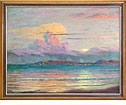

Artist Biography Wellington Jarard Reynolds (1865 – 1949) was born on April 9, 1865 on the family farm in New Lenox, Illinois. His parents, Susan and Joseph Smith Reynolds had eight children, but only two were alive to witness the birth of Wellington, the eighth child.Reynolds entered the school of the recently established Art Institute of Chicago in the fall of 1885. In the Annual Exhibition of June, 1887 he was awarded First Prize in the Antiques Department for a group of seven works. The award was accompanied by a tuition receipt for one term. Reynolds did not apply the award in the fall of 1887, however, for he and his new wife, Frances, left for Europe that October. The couple established themselves in Munich where Wellington entered the Royal Academy. He also studied privately with Simon Hollósy at a small private school called the Hollósy Academy. His wife fell ill however, so the couple returned to the Midwest where Frances died in 1889. Reynolds later returned to Munich with his young son, Ralph, to continue his art studies. Sometime before leaving Munich for Paris in 1894 Wellington married a Chicago miniature artist by the name of Virginia R. Keeney. So it was that Reynolds, together with his second wife, Virginia, and his son, Ralph, established themselves in Paris in the early fall of 1894. Reynolds enrolled at the Académie Julian where he studied with Benjamin Constant and Jean-Paul Laurens. Later he became a student at the Ecole des Beaux-Arts. Reynolds and his family returned to Chicago in 1898 where they took residence in the Tree Studio Building. It was not long before the artist was recognized as one of the best known portrait painters in the city. Tragedy struck again when Virginia died of an embolism on June 11, 1903 while the family was on vacation in Lake Geneva, Wisconsin. A year later Reynolds accepted a position on the faculty of the Academy of Fine Arts as instructor in anatomy. He won a medal in 1908 in the Marshall Field Exhibition and in 1910 the Chicago Society of Artists presented its Medal of Honor to Reynolds for a group of eight portraits and scenes which he had displayed at the Art Institute of Chicago that year. In the fall of 1913 Reynolds joined the Faculty of the Art Institute of Chicago at the invitation of its director, William M. R. French. Reynolds taught at the School of the Art Institute until he was retired with a small pension, the first teacher ever to receive a pension at that institution, in 1938. In 1921 his Ave Maria won the Norman Wait Harris Bronze Medal at the Art Institute; this painting was entered in the Paris Salon in 1925 and won a Silver Medal for Reynolds, the highest award which could be bestowed upon an artist who was not a resident of France. Upon his retirement in 1938 Reynolds returned to the Academy of Fine Art and he reestablished a private studio as well which almost cost him his Art Institute pension. However, ill health and an injury to his back suffered in a fall resulted in the artist being committed to Manteno State Hospital for a period of several years. Eleanor Jewett, the art critic of the Chicago Tribune for over thirty years, and several of her society friends (one of whom had been a student of the artist), secured Reynolds release and established him in a studio in the Artists Colony on East 57th Street near the Museum of Science and Industry. His frailty and dependencies had precluded his ability to earn his living as a teacher, however, and his impaired vision had reduced his ability to produce a body of salable works. Reynolds died while a charity patient in Cook County Hospital on January 22, 1949. Work Available For Sale |
 |  |  |  | |||
© Scanlan Fine Arts Gallery • All rights reserved |